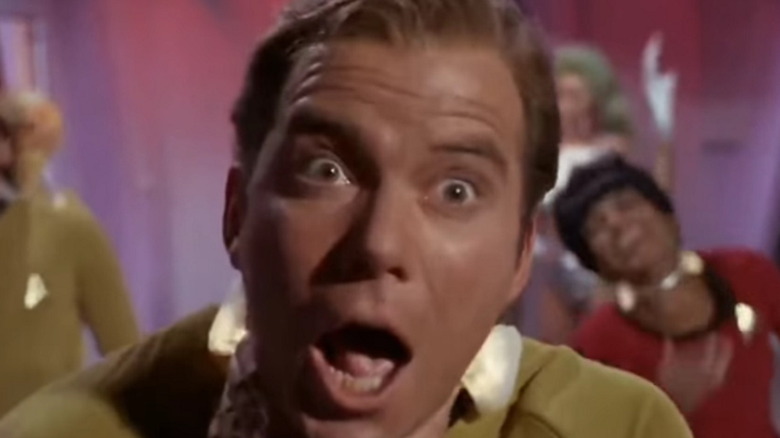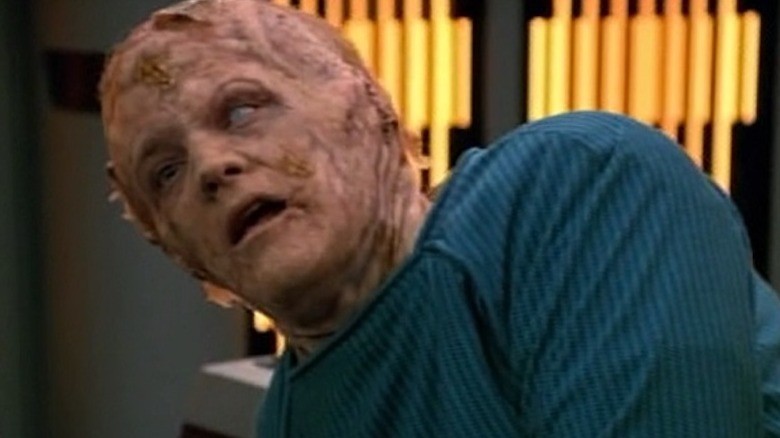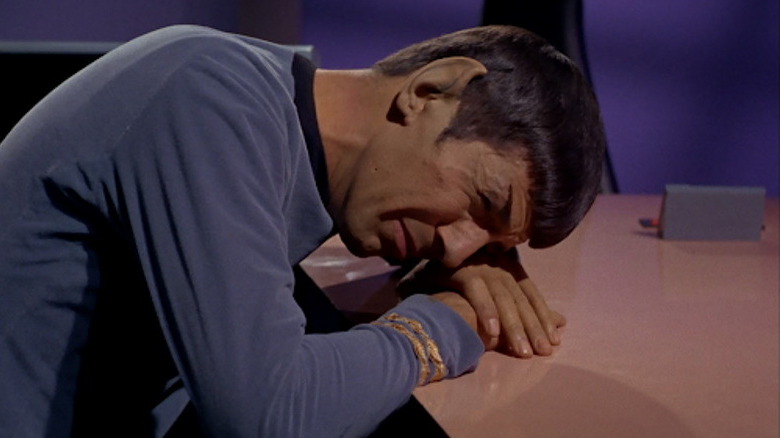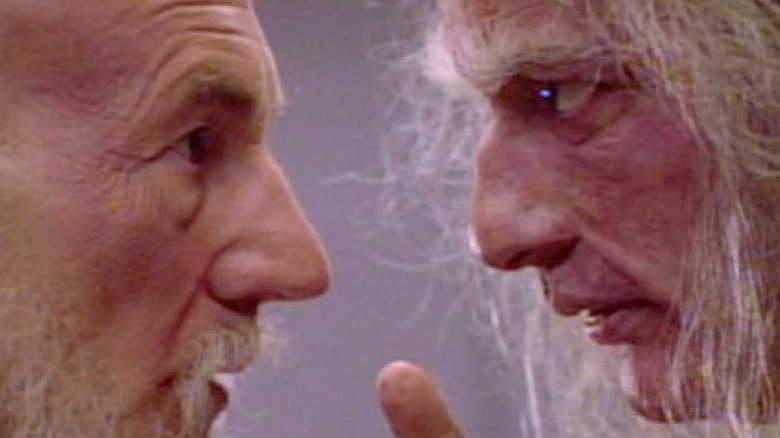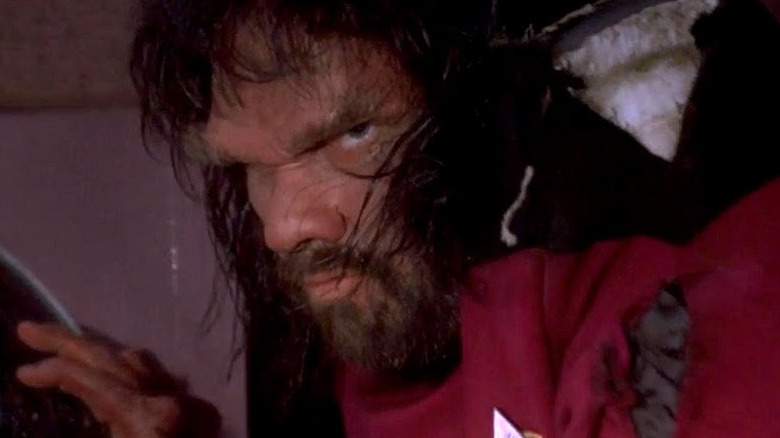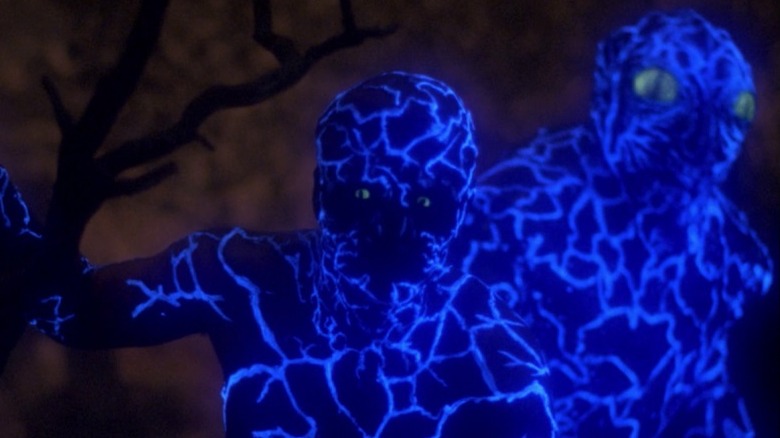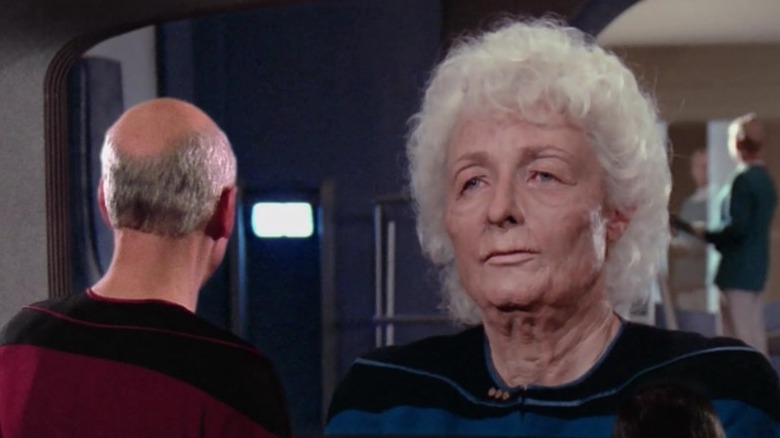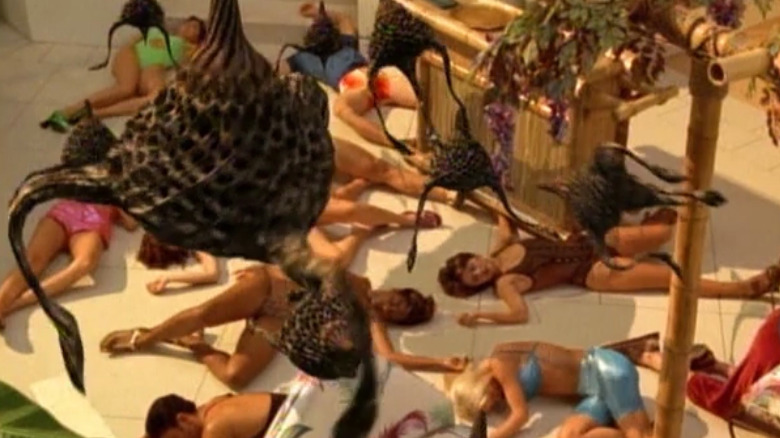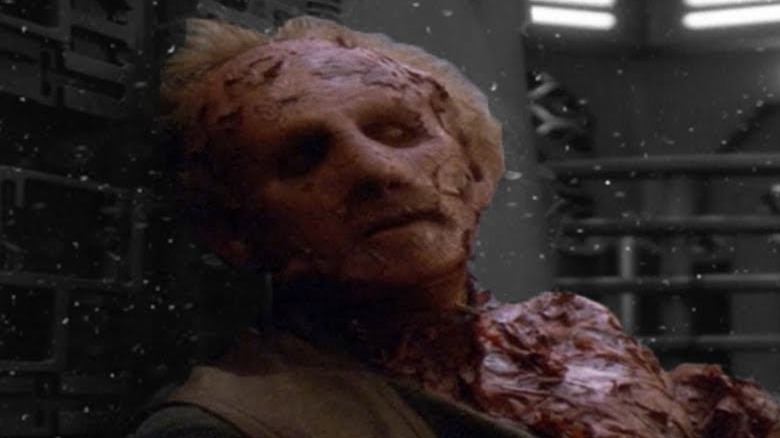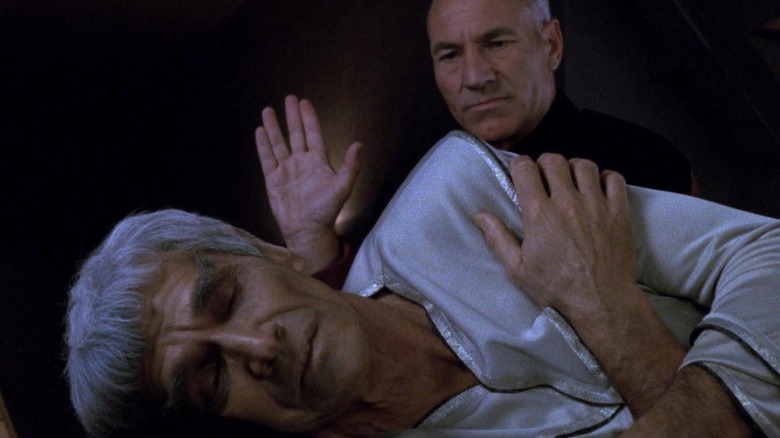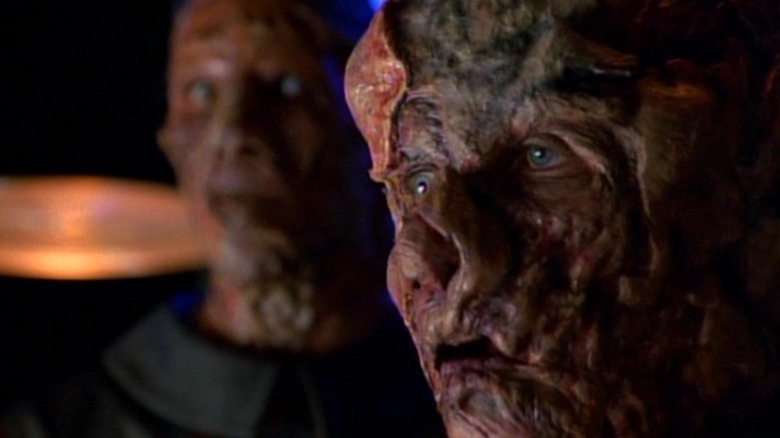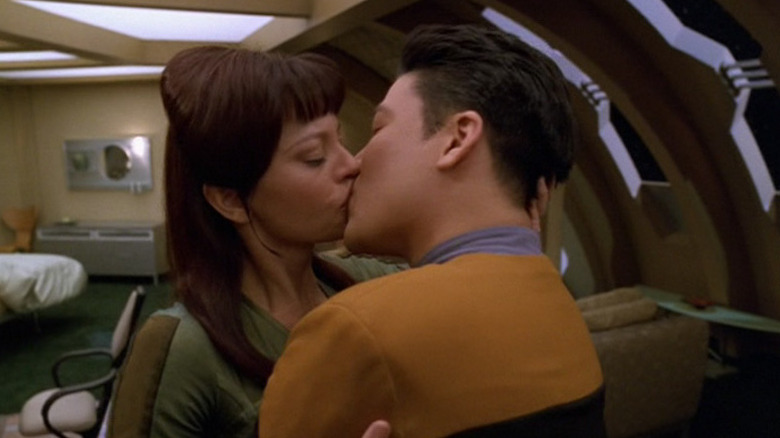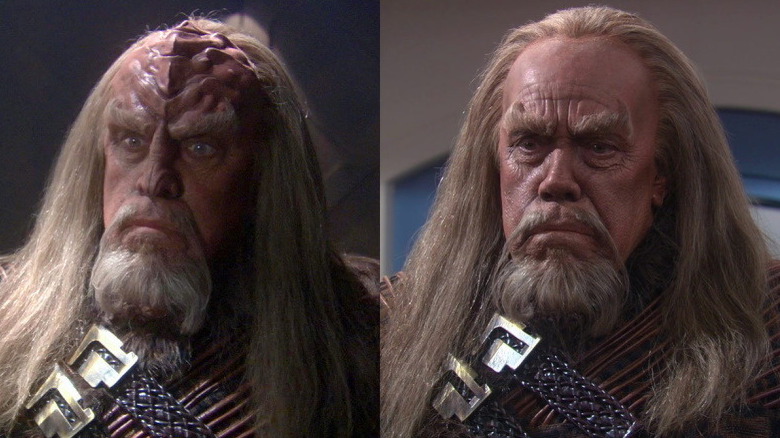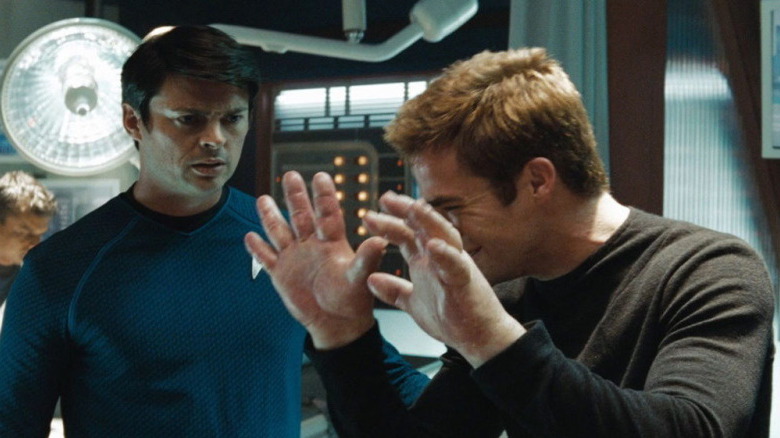The Worst Diseases In The Star Trek Universe
"Space is disease and danger wrapped in darkness and silence."
At first, these words — uttered by Dr. Leonard "Bones" McCoy (Karl Urban) in the 2009 "Star Trek" movie reboot — sound a tad pessimistic. By the 24th century, the common cold has been eradicated and hypo sprays deliver instant cures. McCoy himself (as played by original actor Deforest Kelley) once helped a 20th century kidney dialysis patient grow a brand-new fully functioning kidney with a 23rd century miracle pill in "Star Trek IV: The Voyage Home" (1986) and scoffed that dialysis was something out of "the Dark Ages."
Sure, not all starships have great medical systems (just look at the hospital ship on the "Star Trek: Voyager" Season 7 episode "Critical Care" where people are treated based on social status instead of need, like some galactic HMO), but as far as the Federation is concerned, health care is free and literally universal.
Unfortunately, after taking a closer look at the future depicted in "Star Trek" movies, television shows, and books, it seems McCoy was actually right. 21st century illnesses may have largely been wiped out — but they've been replaced by some nasty new future diseases that can mutate you into a giant spider or force you to fight a giant virus hand-to-hand. For those of you with the stomach for it, steel yourselves: We're about to perform an in-depth examination of the worst diseases you can catch in the "Star Trek" universe.
Breaking the warp barrier turns you into a giant salamander
"Star Trek" offers a glimpse of a utopian future where humanity is constantly seeking to improve itself. Starfleet's mission is to go "where no one has gone before," after all, so it's only natural that people will want to keep pushing the limits of medical science, engineering, and warp propulsion technology.
Unfortunately, as the infamous "Star Trek: Voyager" Season 2 episode "Threshold" revealed, there are some areas even the bold should avoid at all costs. Just ask Lieutenant Tom Paris (Robert Duncan McNeill) who successfully broke the Warp 10 barrier — only to start suffering some very strange symptoms as a result of his history-making flight.
As it turned out, Tom contracted a rare medical condition that causes its unlucky recipients to become allergic to water and unable to breathe oxygen. Hair falls out, skin becomes scaly, and eventually the patient mutates/evolves into a large salamander-like amphibian. In the case of Lt. Paris, this drove him to kidnap Captain Kathryn Janeway (Kate Mulgrew), take her on a Warp 10 joyride and then mate with her on an alien planet after she transformed into a salamander, causing her to have three salamander kids before Voyager rescued them and reversed the process.
Considered one of the worst Star Trek episodes by both the creators and the fans, "Threshold" actually inspired some toymakers to create a mutated Tom Paris action figure, complete with three salamander kids. Suffice it to say, it won't be appearing on shelves in your local Target toy department anytime soon.
Public drunkenness is contagious
Despite being highly-disciplined officers, the crew of the Enterprise do enjoy the occasional alcoholic beverage, and have been known to consume some very intoxicating liquors. However, one disease made it a bit too easy to get drunk.
In the Season 1 episode "The Naked Time" from the original "Star Trek" series and the "Star Trek: The Next Generation" Season 1 episode "The Naked Now," the crews of both the original Enterprise and the Enterprise-D fall victim to variations of "polywater intoxication" (aka the Tsiolkovsky infection or Psi 2000 virus). Those who succumbed experienced a huge suppression of inhibitions, making them act drunk. Perhaps worse, the condition could be spread by touch, making it very easy to intoxicate an entire crew.
During Kirk's time, the virus caused Mr. Sulu (George Takei) to run around the Enterprise half-naked and brandishing a sword, while Spock (Leonard Nimoy) was reduced to a blubbering mess. By the 24th century, the virus has apparently grown so powerful that the android Lieutenant Commander Data (Brent Spiner) passes out after he has drunken sex with Security Chief Tasha Yar (Denise Crosby).
It isn't all pratfalls and gags, however — in both episodes, drunken engineers sabotage the Enterprise and nearly kill everyone before Doctor McCoy and Doctor Crusher (Gates McFadden) devise antidotes to restore everyone's sobriety. That next day must have been one heckuva hangover.
Time travel can drive you mad
In addition to traveling to other planets, Starfleet starships are capable of traveling through time — and by the 29th century, fleets of "timeships" are designed to patrol the time stream and prevent unauthorized tampering with historical events. While the temporal displacement drives can place a person at any moment in history, time travel comes with substantial health risks.
In the "Star Trek: Voyager" Season 5 episode "Relativity," a timeship recruits former Borg drone Seven of Nine (Jeri Ryan), beaming her into the past to prevent a saboteur from destroying the U.S.S. Voyager. Ironically, the saboteur turns out to be an older version of the captain who recruited her after he came down with a case of "temporal psychosis" from using the temporal transporter too many times while dealing with Voyager. Driven mad, he decided to destroy Voyager in an act of revenge.
According to the short story "The Name of the Cat," Doctor McCoy once saved some people by traveling back in time thanks to an alien named Irum. However, the experience affected the entire human genome, including the genes of Yvette Picard, the mother of Captain Jean-Luc Picard (Patrick Stewart). This left Picard in danger of developing Irumodic Syndrome, a disease that makes people behave erratically, slowly lose their minds, and eventually die. So, basically McCoy screwed the entire human species — but to his credit, he did later find a cure.
Gene therapy devolves you into a cave man
Starfleet medicine can cure many diseases, but sometimes those cures end up creating even weirder illnesses. Take Barclay's Protomorphosis Syndrome, a brand-new disease that can devolve you into an ape, a fish, or even a spider. In the "Star Trek: The Next Generation" Season 7 episode "Genesis," hypochondriac Lieutenant Reginald Barclay (Dwight Schultz) gets injected with a synthetic T-cell to activate some genes, giving him an immunity to Urodelan flu.
Instead, the T-cell activates all of his ancient genes and merges with the flu virus, becoming an airborne illness that devolves everyone into an earlier form of life.
So, Barclay mutated into a spider, Worf (Michael Dorn) became a venom-spitting savage, Riker (Jonathan Frakes) regressed into a Neanderthal, Counselor Troi (Marina Sirtis) splashed around in her bathtub as a fish-woman, and Data's cat Spot became an iguana. Fortunately, the android Data was immune to the disease, managing to create a retrovirus that restored everyone to normal.
Behind the scenes, "Genesis" is the only "TNG" episode directed by Gates McFadden, who played Doctor Crusher. To give her more time in the director's chair, the script had Worf spit venom in Crusher's face early in the story, forcing her to have reconstructive surgery and stay off-screen. Uh, thanks Worf.
Parasites mutate you into a glow-in-the-dark alien
Starfleet directs its crews to "seek out new life," but one virus can actually turn you into that new life — and the results aren't pretty. In "Identity Crisis," from Season 4 of "Star Trek: The Next Generation," several random crewmembers fell victim to a virus that rewrites DNA and turns the victim into primitive alien creatures that can turn invisible or glow in the dark.
The virus infected Lieutenant Geordi La Forge (LeVar Burton), but because he's a main character — er, recently infected — the Enterprise was able to save him and reverse the process. Sadly, the transformation was permanent for the more anonymous Starfleet officers, who basically had to live out the rest of their lives as glow-in-the-dark blue monkeys on a jungle planet.
Behind the scenes, the mutated versions of the unfortunate crewmembers were played by Mark Thompson and Brian Phelps, hosts of the nationally syndicated KLOS radio talk show "Mark & Brian" and the TV show "The Adventures of Mark & Brian." Running around in a glowing blue body stocking probably isn't how most people think they'll end up on "Star Trek" — but it's one heck of a thing to cross off of your bucket list.
Catching the flu accelerates your aging
Most Earth-based versions of the flu have been eradicated by the 24th century, but one new alien variation can really screw up your life — by turning you into a senior citizen within a day.
In the "Star Trek: The Next Generation" Season 2 episode "Unnatural Selection," the Enterprise encountered a group of genetically-engineered "super children" with perfect immune systems. Unfortunately, one of the antibodies from these immune systems mutates a harmless virus into a rapid-aging disease — and in the episode, it caused the crew of an entire supply ship to grow old and die within hours.
One of the Enterprise's own crewmembers, Doctor Katherine Pulaski (Diana Muldaur) also caught the disease and began deteriorating physically. Since they couldn't afford to lose another medical officer from the main cast (Pulaski replaced Doctor Beverly Crusher in Season 2 after Gates McFadden was temporarily fired) the Enterprise's crew came up with a way to use the transporters to rewrite Pulaski's DNA — effectively discovering the secret of eternal life — and then proceeded to do absolutely nothing with this ground-breaking discovery.
In truth, accelerated aging is a surprisingly common trope/disease in the "Star Trek" franchise. In the Season 2 episode "The Deadly Years," radiation from a comet caused the crew to suffer from accelerated aging. Fortunately, Doctor McCoy managed to reverse the aging effect by injecting the crew with an adrenaline-based compound. Who knew aging could be conquered so easily?
Viruses can get big. Very big.
Starfleet medical doctors battle nasty new viruses all the time — but one virus from the Delta Quadrant learned how to fight back using very dirty tactics.
In the Season 3 episode "Macrocosm" from "Star Trek: Voyager," a virus incorporated the growth hormones of its host, allowing it to infect the bio-neural gel packs on the ship as well as multiple crewmembers. It then multiplied and "hatched' through their skin, growing into giant "macroviruses" with nasty retractable stingers capable of impaling its victims (and you thought the Xenomorphs from "Aliens" were bad...)
Enter Captain Kathryn Janeway, doing her best Ellen Ripley-impersonation. Wearing a sweaty tank top and carrying a really big space-rifle, Janeway blasted one virus with a laser, engaged another in a knife fight, and finally lured them all into the holodeck using the bio-electric signatures of holographic beach party goers as bait. Tossing an "antigen bomb" into the holodeck, Janeway killed the ship-wide infection with a massive burst of antiviral gas. Clearly, this was one captain you did not want to mess with.
Biological warfare is still practiced by the Federation
During the Dominion War depicted in "Star Trek: Deep Space Nine," the shapeshifting Founders created the Teplan blight, an engineered virus designed to eradicate the Teplan people of the Gamma Quadrant when they resisted the Founders attempts to dominate them. The Blight decimated their population and many infected people found euthanasia preferable to living with the pain of the disease. While Dr. Julian Bashir (Alexander Siddig) developed a vaccine that prevented transmission of the disease to future generations, the Founders had set the Teplan people's culture back hundreds of years.
It sounds horrible, but some of the "enlightened" people of the Federation aren't much better. In another storyline, Bashir discovered that Section 31, a rogue agency within Federation Starfleet, created a "morphogenic virus" and infected Bashir's friend Constable Odo (Rene Auberjonois). Odo went on to infect multiple Founders who found it left their morphogenic matrix unstable and kept them from using their shapeshifting abilities. Essentially, Section 31 caused the virus to commit mass genocide — and nearly succeeded.
Odo was eventually able to rejoin with his shapeshifting brethren and cure them, but the fact that members of the Federation were willing to look the other way as Section 31 betrayed all of Starfleet's ideals is disturbing. Humanity may have evolved in the Star Trek universe, but if we're not careful, we can still slip right back into some very bad habits.
Vulcan neurological conditions make everything ... illogical
Vulcans prize logic and emotional control over everything else — so it stands to reason that the worst affliction for their race would take away all of that. Bendii Syndrome is a mental condition that affects a minority of Vulcans over the age of 200. Those who suffer from this disease not only lose their emotional control, they also begin telepathically projecting their rampant emotions onto those around them, infecting others with the emotional turbulence normally held in check by Vulcan logic.
One Vulcan who suffered the effects of Bendii Syndrome was none other than Ambassador Sarek (Mark Lenard), the father of Mr. Spock, in the "Star Trek: The Next Generation" Season 3 episode "Sarek." Unable to control himself long enough to mediate a final treaty, Sarek gained a moment of reprieve through an unconventional treatment — mind-melding with Captain Jean-Luc Picard and gaining the captain's self-control while Picard suffered in Sarek's stead. The experience nearly broke Picard, but left him with an understanding of Sarek to the point where Spock admitted Picard may know his father better than he did.
Sadly, Bendii Syndrome would eventually claim Sarek's life and he died unable to focus long enough to complete the traditional Vulcan salute, "live long and prosper." His end in the TNG Season 5 storyline "Unification" is tragic and his symptoms are very similar to those suffering Alzheimer's disease. "Star Trek" diseases may seem exotic, but they still have roots in very real conditions.
Space leprosy is terrifying
Weird illnesses and even entire plagues can be cured within the span of a single episode in "Star Trek" television series — but what if you're an alien race who doesn't have a Doctor McCoy or Julian Bashir running your hospitals? Then your entire planet might end up like the Vidiians' homeworld, which became the equivalent of a world-wide leper colony.
When the U.S.S. Voyager first encountered the Vidiians in the Season 1 episode "Phage," they had been suffering from the "Phage," a disease that gradually devoured the tissues of their body, for 2000 years.
To survive, the Vidiians became masters of transplantation and organ removal — often extracting organs from healthy beings while the "donor" was still alive. This turned them into a race of kidnappers and organ thieves who didn't even bother with sticking you in a bathtub full of ice to cut out your liver — they just teleport any parts they need straight out of your body.
At one point, Voyager's holographic EMH Doctor (Robert Picardo) managed to "cure" a Vidiian scientist temporarily by transferring her consciousness into a holographic body. Surprisingly, the woman who emerged was a kind-hearted, empathetic person who hated the idea of returning to her diseased organic form. However, she later decided she had a duty to help find a cure and restore her people to the artists and explorers they once were.
You can literally get "love sick"
Some diseases are really just a matter of your point of view. Take love sickness, for example.
In the aptly-named Season 5 episode "The Disease" of "Star Trek: Voyager," Ensign Harry Kim (Garrett Wang) got into a relationship with a female Varro engineer named Derran Tal (Musetta Vander), only to discover that sex with the Varro created an "olan'vora" or "shared heart," resulting in a lasting biochemical connection between two partners.
Although the bond is typical in Varro mating rituals, it caused Harry's skin to glow as he became psychologically linked with Tal to the point where he began neglecting his duties to be with her. At one point, the former Borg drone Seven of Nine (Jeri Ryan) compared love to a disease, saying it is "a series of biochemical responses that trigger an emotional cascade," although she later reconsidered her opinion after seeing how Harry was willing to suffer through the "symptoms."
Even so, when Tal left the ship at the end, both she and Harry went through an uncomfortable period of withdrawal, giving new meaning to the term "love sick." A word to the wise: Be careful of who you sleep with when seeking out brave new worlds.
Levodian flu clears up retcons
One of the great mysteries surrounding Star Trek's Klingons is why they look so different depending on what television show or movie they appear in. In the original series, the Klingons looked essentially human, but with smooth foreheads and bronze skin. However, by the time the Klingons appeared in the movies and "The Next Generation," they had some distinctive forehead ridges and sharp teeth, unlike their earlier counterparts.
Behind-the-scenes, the answer is simple — makeup artists on the original "Trek" television shows didn't have the time or budget to create an elaborate makeup job, while modern-day FX artists have access to better prosthetics that give the Klingon their distinctive alien look. Within the Star Trek universe, however, the mystery has been attributed to a disease — the Levodian flu.
In the "Star Trek: Enterprise" Season 4 episodes "Affliction" and "Divergence," we learned that 23rd century Klingon scientists genetically augmented certain Klingons to produce superior warriors. However, the process erased the Klingons' forehead ridges and merged with the Levodian flu virus, creating an epidemic that physically altered many Klingons. Enterprise's Doctor Phlox (John Billingsley) helped develop a cure, but it would be some time before Klingons regained their forehead ridges.
The incident proved so embarrassing that Lieutenant Commander Worf claimed Klingons don't discuss it with "outsiders." Given how much trouble a flu virus caused the Empire, it's probably a good idea to refrain from sneezing around these guys. You might just be put to death.
Some cures are worse than the disease
In the "Star Trek: Enterprise" Season 2 episode "Canamar," one alien spoke about how he liked eating "Melvaran mud fleas" that jump up and down in your mouth as you crunch on them. That sounds pretty disgusting — which is probably why Starfleet doctors of the Kelvin timeline created the "mud flea vaccine" that Doctor Leonard "Bones" McCoy gave to Cadet James Kirk (Chris Pine) in "Star Trek" (2009).
Bones gave the vaccine to Kirk so his friend would show the symptoms of the mud flea disease (which includes losing vision in your left eye, a really bad headache, and "flop sweat"), that way he had an excuse to sneak him onto the Enterprise. However, Kirk ended up having a much more serious reaction to the vaccine, waking up in sick bay and discovering his hands had swollen to three times their normal size. He then tried to speak with Lietenant Uhura (Zoë Saldana), only to learn the hard way that the "numb tongue" Bones' miracle cure gave him made speaking practically impossible.
Ultimately, McCoy had to inject his friend with multiple other vaccines, just to restore Kirk's hands and tongue to normal, showing that while he may be one of the best doctors in Starfleet, he can also cause as many issues as he solves.
Given this, maybe Bones wasn't talking about different planets when he grumbled about the disease and danger Starfleet cadets faced — but the "space" inside his own medical bay.
